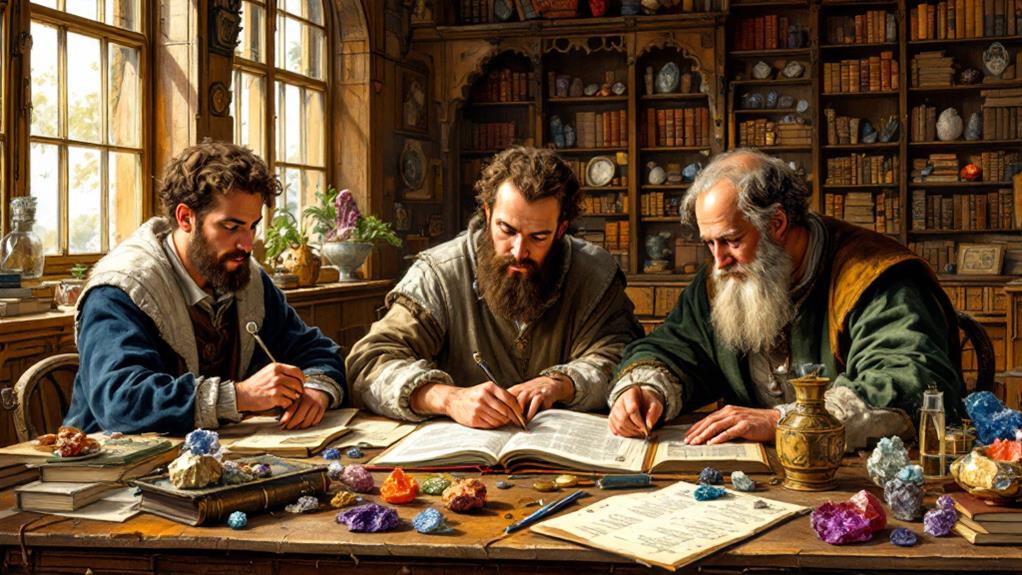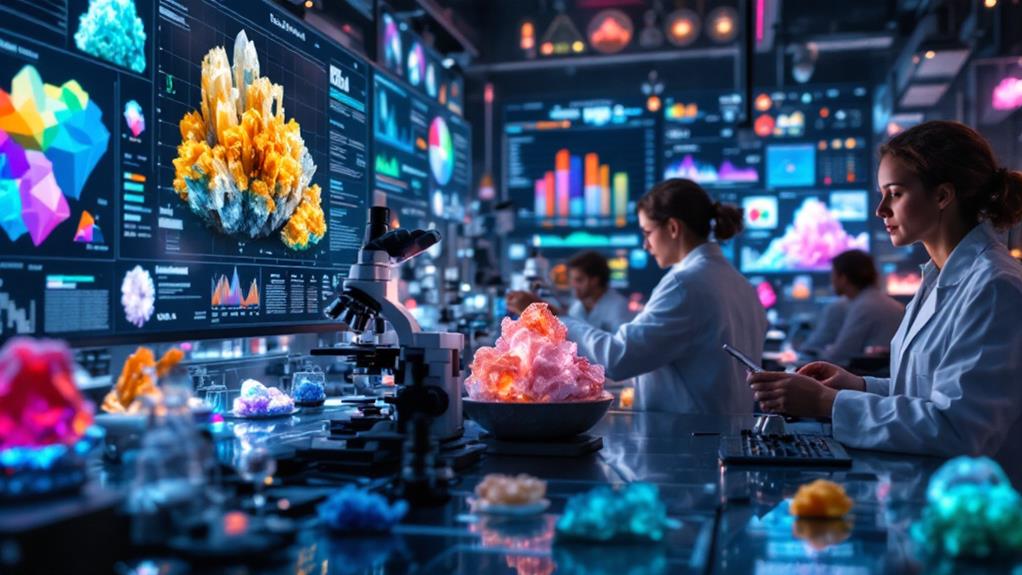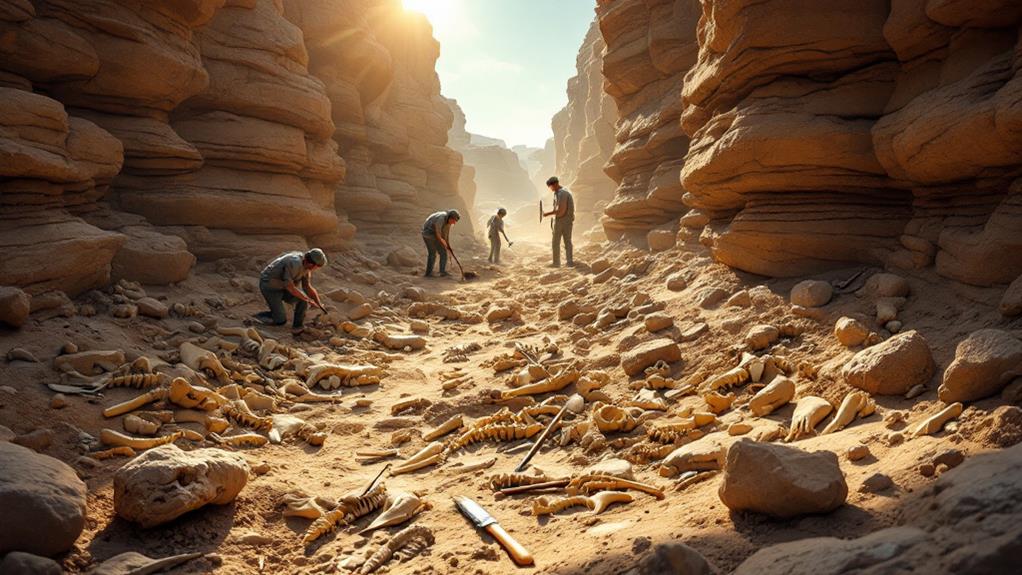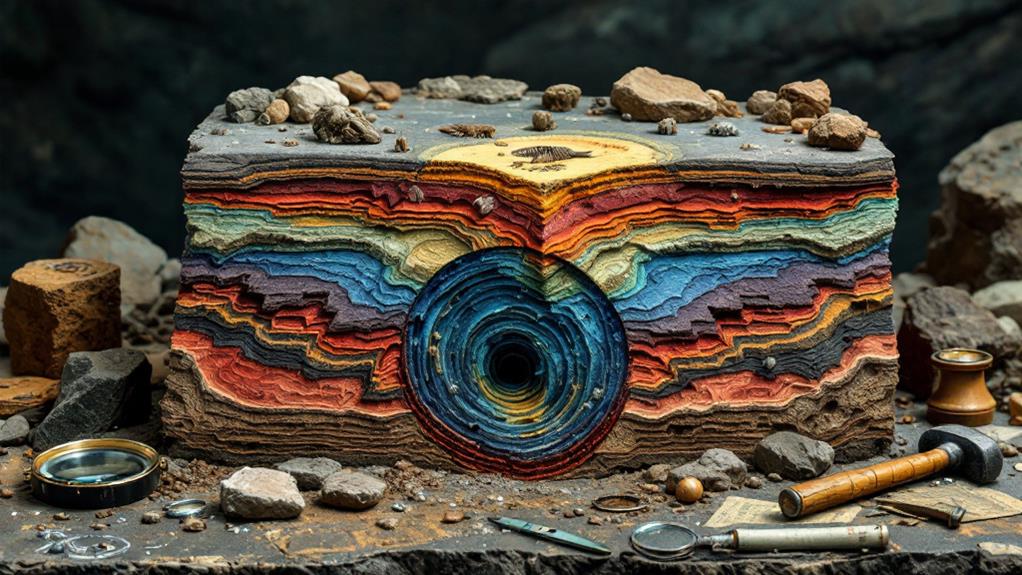The History of Mineralogy: The Study of Earth's Minerals

Imagine tracing mineralogy from ancient Egyptians using malachite as makeup to the Greeks wielding hematite for war paint. You'll uncover how Chinese reverence for jade exemplified minerals' cultural significance. Fast forward to medieval times when alchemical pursuits revealed deeper mineral understanding. The Renaissance brought systematic studies, with Georgius Agricola's pioneering works. In the 18th century, classification systems and Mohs' hardness scale transformed identification. Modern mineralogy employs advanced techniques like electron microscopy and X-ray diffraction. Each leap reflects evolving technology and methodology in understanding Earth's minerals. Keep exploring to unveil the intricate expedition of mineralogic discoveries through time.
Ancient Observations
Long before modern science took shape, ancient civilizations made remarkable observations of minerals around them. You'd be amazed at how these early societies utilized their keen understanding of the natural world. Ancient texts reveal that Egyptians, Greeks, and Chinese documented mineral usage extensively, each culture contributing unique insights. The Egyptians crafted lively pigments from malachite and azurite for their art and cosmetics. Meanwhile, the Greeks' fascination with minerals is evident in their mythology and practical applications, like using hematite and ochre as protective talismans or war paint.
In China, you'd find ancient texts detailing the use of jade, not only as a symbol of status but also for spiritual and medicinal purposes. You can see how these early observations were more than just trial and error; they were thoughtful studies of the natural properties and potential benefits of minerals. Ancient societies didn't just use minerals for decoration or trade; they investigated their properties for healing and spiritual improvement.
Medieval Developments
During the medieval period, mineralogy experienced significant advancements as curiosity and exploration took center stage. You'll find that medieval scholars were enthusiastic to uncover the mysteries of minerals and their properties. Unlike earlier times, the approach was more structured, and the fusion of science and mysticism, particularly through alchemical practices, played a crucial role. Alchemy wasn't just about turning base metals into gold; it was also about understanding the transformative properties of minerals.
Here's how medieval developments in mineralogy unfolded:
- Textual Documentation: Scholars began to document their observations systematically, creating a foundation of knowledge for future generations.
- Alchemical Influence: Alchemical practices led to a deeper understanding of mineral properties beyond their physical appearance, focusing on what made these minerals unique.
- Trade and Exploration: Expanding trade routes brought new minerals from distant lands, sparking further study and interest in their properties and uses.
- Cathedrals and Architecture: The demand for beautiful stained glass and intricate stonework in cathedrals pushed for more refined techniques in utilizing minerals.
You can see how these elements combined to create a rich tapestry of mineralogical knowledge that would set the stage for future breakthroughs.
Renaissance Contributions

The Renaissance period marked a significant shift in mineralogy, as the rebirth of classical knowledge and the spirit of inquiry fueled unprecedented advancements. You'd find that scientific curiosity blossomed during this period, with scholars enthusiastically exploring the natural world, including minerals. This renewed interest in ancient texts, combined with groundbreaking thinking, led to a deeper understanding of Earth's minerals. The period's artistic influence also played a role, encouraging careful observation and accurate depiction of mineral samples, which became vital for study and documentation.
During the Renaissance, you would have encountered pioneering figures like Georgius Agricola, whose work laid the groundwork for modern mineralogy. His book, "De Re Metallica," detailed mining and refining processes, showcasing a blend of technical expertise and scientific curiosity. Agricola's systematic approach to mineral classification and description was groundbreaking, allowing you a glimpse into the thorough study of minerals.
You'll appreciate how Renaissance artists and scientists alike contributed to mineralogy's progress. Artists, driven by realism, carefully illustrated minerals, enhancing their visibility and understanding. Meanwhile, scientists, inspired by artistic precision, adopted a methodical approach that advanced mineralogical research, setting the stage for future findings.
18th Century Classification
As you investigate the 18th Century Classification of minerals, you'll find the time was marked by a systematic approach that transformed mineralogy. This period focused on organizing and categorizing minerals based on observable characteristics, laying the groundwork for modern mineralogical studies. A key development was the classification of minerals through crystal systems and mineral properties, which helped create a thorough understanding of Earth's riches.
Consider the following advancements:
- Crystal Systems: This classification outlined minerals into distinct groups based on their geometric crystal forms. The seven crystal systems emerged, including cubic, tetragonal, and hexagonal, each with unique symmetry elements.
- Hardness Scale: Friedrich Mohs introduced a method to determine mineral hardness, arranging them on a scale from talc (softest) to diamond (hardest). This scale remains fundamental in mineral identification.
- Chemical Composition: Chemists began analyzing minerals' chemical elements, leading to a deeper comprehension of mineral properties. This insight allowed for more precise categorization beyond mere appearance.
- Optical Properties: The study of how minerals interact with light became fundamental, aiding in the identification and classification process. Understanding birefringence, luster, and color improved mineral differentiation.
This systematic approach transformed how you perceive minerals, blending art and science into a cohesive discipline.
Modern Mineral Analysis

Jump into the realm of modern mineral analysis, where cutting-edge technology and groundbreaking methods redefine how we grasp Earth's minerals. Today, X-ray diffraction plays a significant role in determining the atomic structure of minerals. By analyzing how X-rays scatter when they hit a mineral sample, you can pinpoint its precise crystal structure, providing vital insights into its properties and classification.
Electron microscopy is another indispensable tool in your arsenal. It allows you to visualize minerals at an atomic level, revealing details that are invisible to the naked eye. This technique is essential for accurate mineral identification, helping you distinguish even the most similar-looking specimens.
Spectroscopy techniques further improve your understanding by exposing the chemical composition of minerals. Regardless of whether through infrared, Raman, or other methods, spectroscopy offers a non-destructive way to analyze mineral samples, ensuring you preserve them for future study.
Automated analysis and geochemical methods streamline the process, reducing human error and increasing efficiency. With these advancements, you can conduct thorough mineral analyses faster and more accurately than ever before. Adopt these technologies to discover the secrets hidden within Earth's minerals, expanding your knowledge and appreciation of the natural world.
Technological Impacts
In recent years, rapid technological advancements have transformed the field of mineralogy, offering you unprecedented tools and methods to study Earth's minerals. These innovations boost your understanding of mineral compositions and structures and redefine the scope of industrial applications. Cutting-edge mineral technology provides you with the precision and efficiency needed to investigate and exploit mineral resources more sustainably.
Here's how technology impacts your study and use of minerals:
- Remote Sensing: You can now utilize satellite and aerial imaging to detect mineral deposits from afar, saving time and resources.
- 3D Modeling: With advanced software, you can create detailed models of mineral structures, enabling better analysis and prediction of behavior under different conditions.
- Automated Mineralogy: Automation allows you to process large sets of mineral samples quickly, improving both speed and accuracy in mineral identification.
- Industrial Applications: Improved mineral technology leads to more efficient extraction and processing methods, minimizing waste and environmental impact.



